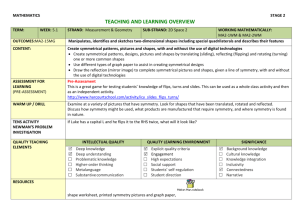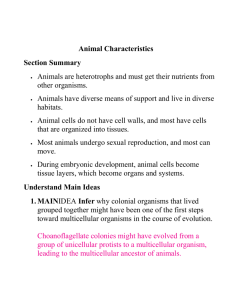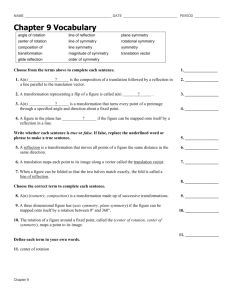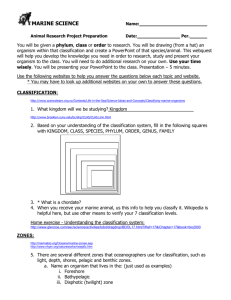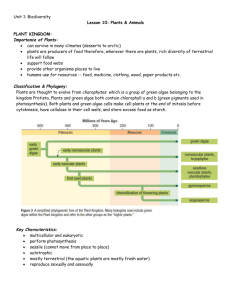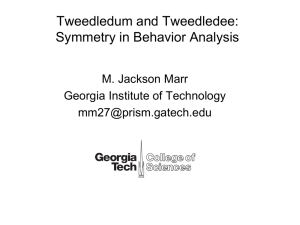2D - Stage 3 - Plan 4b - Glenmore Park Learning Alliance
advertisement
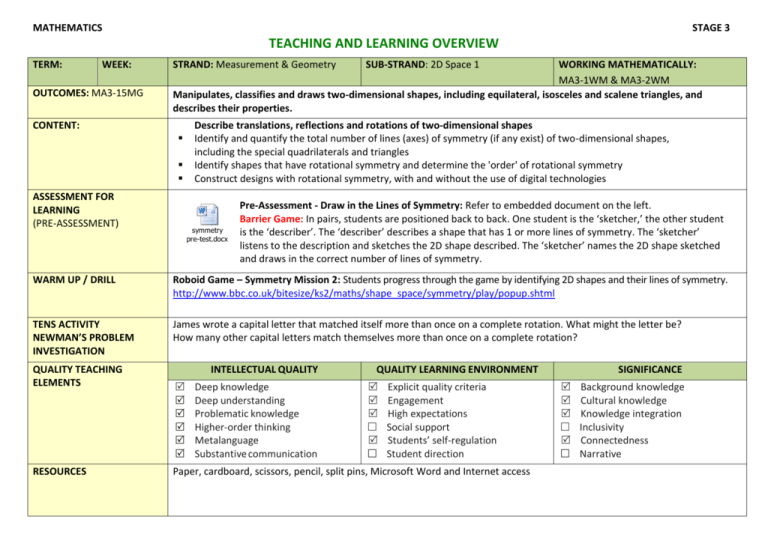
MATHEMATICS STAGE 3 TEACHING AND LEARNING OVERVIEW TERM: WEEK: OUTCOMES: MA3-15MG STRAND: Measurement & Geometry WORKING MATHEMATICALLY: MA3-1WM & MA3-2WM Manipulates, classifies and draws two-dimensional shapes, including equilateral, isosceles and scalene triangles, and describes their properties. CONTENT: ASSESSMENT FOR LEARNING (PRE-ASSESSMENT) SUB-STRAND: 2D Space 1 Describe translations, reflections and rotations of two-dimensional shapes Identify and quantify the total number of lines (axes) of symmetry (if any exist) of two-dimensional shapes, including the special quadrilaterals and triangles Identify shapes that have rotational symmetry and determine the 'order' of rotational symmetry Construct designs with rotational symmetry, with and without the use of digital technologies symmetry pre-test.docx Pre-Assessment - Draw in the Lines of Symmetry: Refer to embedded document on the left. Barrier Game: In pairs, students are positioned back to back. One student is the ‘sketcher,’ the other student is the ‘describer’. The ‘describer’ describes a shape that has 1 or more lines of symmetry. The ‘sketcher’ listens to the description and sketches the 2D shape described. The ‘sketcher’ names the 2D shape sketched and draws in the correct number of lines of symmetry. WARM UP / DRILL Roboid Game – Symmetry Mission 2: Students progress through the game by identifying 2D shapes and their lines of symmetry. http://www.bbc.co.uk/bitesize/ks2/maths/shape_space/symmetry/play/popup.shtml TENS ACTIVITY NEWMAN’S PROBLEM INVESTIGATION James wrote a capital letter that matched itself more than once on a complete rotation. What might the letter be? How many other capital letters match themselves more than once on a complete rotation? QUALITY TEACHING ELEMENTS RESOURCES INTELLECTUAL QUALITY Deep knowledge Deep understanding Problematic knowledge Higher-order thinking Metalanguage Substantive communication QUALITY LEARNING ENVIRONMENT Explicit quality criteria Engagement High expectations Social support Students’ self-regulation Student direction Paper, cardboard, scissors, pencil, split pins, Microsoft Word and Internet access SIGNIFICANCE Background knowledge Cultural knowledge Knowledge integration Inclusivity Connectedness Narrative TEACHING AND LEARNING EXPERIENCES WHOLE CLASS INSTRUCTION MODELLED ACTIVITIES Explicitly communicate lesson LEARNING outcomes and work quality. SEQUENCE Define and Reinforce Remediation metalanguage used in the unit; S2 or Early S3 shape, two-dimensional shape (2D shape), triangle, equilateral Symmetry triangle, isosceles triangle, scalene remediation activities.docx triangle, right angled triangle, quadrilateral, parallelogram, LEARNING rectangle, rhombus, square, SEQUENCE trapezium, kite, pentagon, S3 hexagon, octagon, regular shape, irregular shape, features, properties, side, parallel, pair of parallel sides, opposite, length, vertex (vertices), angle, right angle, line (axis) of symmetry, rotational symmetry, order of rotational symmetry, translate, reflect, rotate and enlarge. Demonstration: Teacher demonstrates how to identify and LEARNING quantify the total number of lines SEQUENCE (axes) of symmetry (if any exist) of 2D shapes, including the special Extension quadrilaterals and triangles. Early S4 http://www.innovationslearning.c o.uk/subjects/maths/activities/yea r3/symmetry/shape_game.asp EVALUATION & http://www.bbc.co.uk/bitesize/ks3 REFLECTION /maths/shape_space/symmetry/ac tivity/ GUIDED & INDEPENDENT ACTIVITIES Paper cutting: Students fold Brennex squares and cut patterns to create symmetrical shapes. Additional activities can be found in the embedded document to the left. Flags: Students investigate and create flags which have symmetry. Please refer to embedded document to the left. Interactive Activity: Students investigate symmetry in the related interactive game at http://www.fuelthebrain.com/Game/play.php?ID=302http://swgfl.skoool.co.uk/content/ke ystage3/maths/pc/learningsteps/SYMLC/launch.html Magazine Picture Hunt: Students look for pictures in magazines that have symmetry. Link to art lesson where students cut one of these images in half and replicate the opposing symmetrical side using media of choice or create butterflies using paint splodges. Symmetrical Designs: Students create symmetrical designs using 1, 2 and 4 lines of symmetry on grid paper as shown in diagram below. Examples Folding Task: Students explore lines of symmetry in a range of 2D shapes by folding cut-outs of various shapes. Photography: Students take photographs of symmetry in the natural environment and record their findings using computer technologies. Tutorial: Students investigate rotational symmetry at http://www.eduplace.com/cgi bin/schtemplate.cgi?template=/kids/mw/help/eh_popup.thtml&grade=5&chapter=15&less on=9&title=Symmetry&tm=tmff1509e\ Interactive Tool: Students investigate axial symmetry (vertical, horizontal and diagonal) at http://swgfl.skoool.co.uk/content/keystage3/maths/pc/learningSimulations/ASXSC/launch.html Student Engagement: Resources: Achievement of Outcomes: Follow up: TEACHING AND LEARNING EXPERIENCES WHOLE CLASS INSTRUCTION MODELLED ACTIVITIES Explicitly teach the concept of rotational symmetry. http://www.flashymaths.co.uk/swf/rsym metry.swf GUIDED & INDEPENDENT ACTIVITIES LEARNING SEQUENCE Remediation S2 or Early S3 LEARNING SEQUENCE S3 Student Extension Activity Students mark all lines of symmetry on the 26 letters of the alphabet. They then colour the letters that have turn symmetry. The alphabet letters are then categorised into the four groups below. 1. Line symmetry only (12 letters) 2. Line and turn symmetry (4 letters) 3. Turn symmetry only ( 3 letters) 4. No symmetry – (7 letters) LEARNING SEQUENCE Extension Early S4 EVALUATION & REFLECTION Students view the interactive activity below to clarify the terms translation, rotation and reflection. http://www.bbc.co.uk/bitesize/ks3/maths/shape_space/transformations1/activity/ What does rotate mean? Students use body movement to rotate themselves 360 degrees in 90 degree increments e.g. Students find a point in the room and face a corner. Staying on the point, rotate for a quarter of a circle, or 90°.You should now face the next corner. Continue rotating to the next corner. You have rotated a half circle, or 180°.Continue rotating, until you face the corner where you started. You have rotated a full circle or 360°. Add additional relevant activities such as clockwise etc while playing “Simon Says”. Students who make incorrect rotations are out. Play until there is a winner. Students identify shapes that have rotational symmetry and determine the 'order' of rotational symmetry. Students are given a variety of cardboard shapes to investigate their rotational symmetry by pinning each shape through the centre to grid paper and tracing the shapes onto the paper. While the cardboard shape remains still, students rotate the tracing around the pin. Students draw other shapes onto grid paper and predict whether they have rotational symmetry. They then check their predictions. Students construct a variety of designs with rotational symmetry using digital technologies. Open a Word document and bring up the drawing toolbar. Using AutoShapes, make a rectangle, or use the rectangle icon on the drawing toolbar. Repeat this with other shapes. Note: When using AutoShapes, pressing the shift key before drawing, and holding it down while drawing, forces the shape to be regular. For example, using the shift key will force a rectangle to be a square, an oval to be a circle, a triangle to be equilateral, a pentagon to be regular etc. Repeat using other shapes. Students make two columns; one for shapes that match themselves more than once when rotated in a full circle and one for those that don’t. They then print out their Word document and email it to their teacher. Investigation: James wrote a capital letter that matched itself more than once on a complete rotation. What might the letter be? How many other capital letters match themselves more than once on a complete rotation. See alphabet sheet below. Students play Rotation Mania using the file below. Rotation mania.docx alphabet.docx Student Engagement: Resources: Achievement of Outcomes: Follow up:


